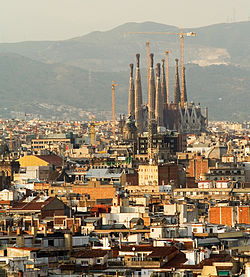Eixample
[1] The Eixample is characterized by long straight streets, a strict grid pattern crossed by wide avenues, and square blocks with chamfered corners (named illes in Catalan, manzanas in Spanish).
This was a visionary, pioneering design by Ildefons Cerdà, who considered traffic and transport along with sunlight and ventilation in coming up with his characteristic octagonal blocks, where the streets broaden at every intersection making for greater visibility, better ventilation and (today) some short-term parking areas.
The grid pattern remains as a hallmark of Barcelona, but many of his other provisions were ignored: the four sides of the blocks and the inner space were built instead of the planned two or three sides around a garden; the streets were narrower; only one of the two diagonal avenues was carried out; the inhabitants were of a higher class than the mixed composition dreamed of by Cerdà.
The square architecture of Eixample was the main inspiration for the controversial jersey checkerboard design introduced by FC Barcelona in 2019 instead of the traditional stripes, and used until the following year.
Passeig de Gràcia connects the central Plaça Catalunya to the old town of Gràcia, while Avinguda Diagonal cuts across the grid diagonally and Gran Via de les Corts Catalanes runs across the entire city from southwest to northeast.



